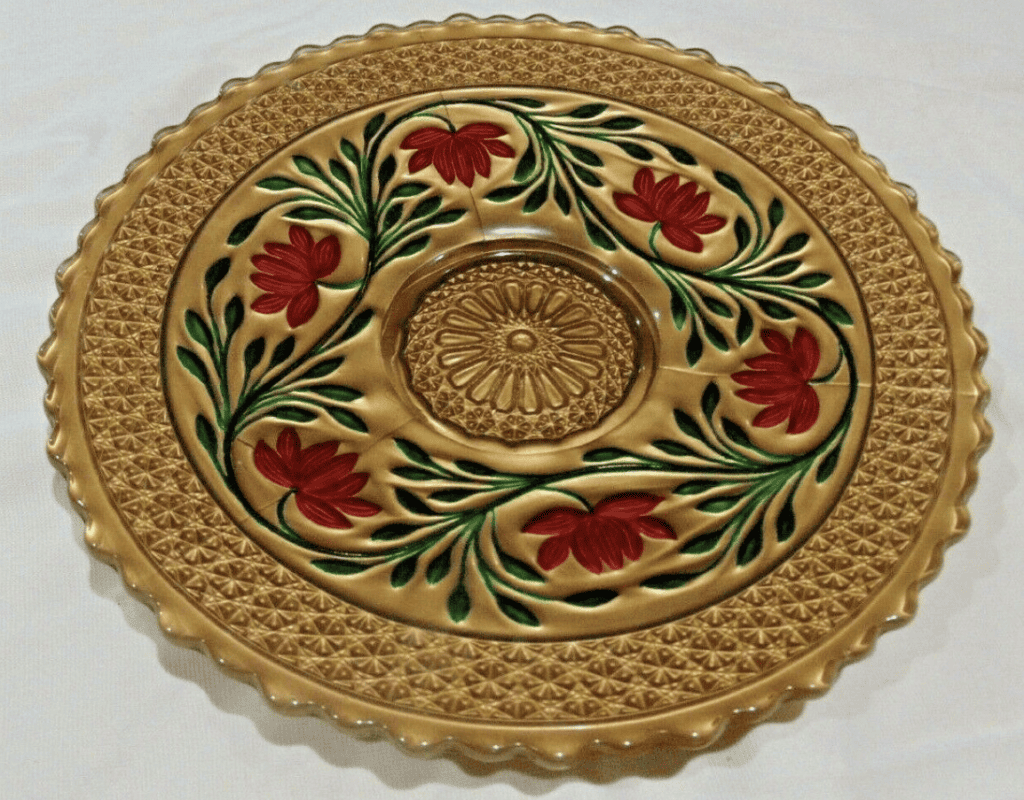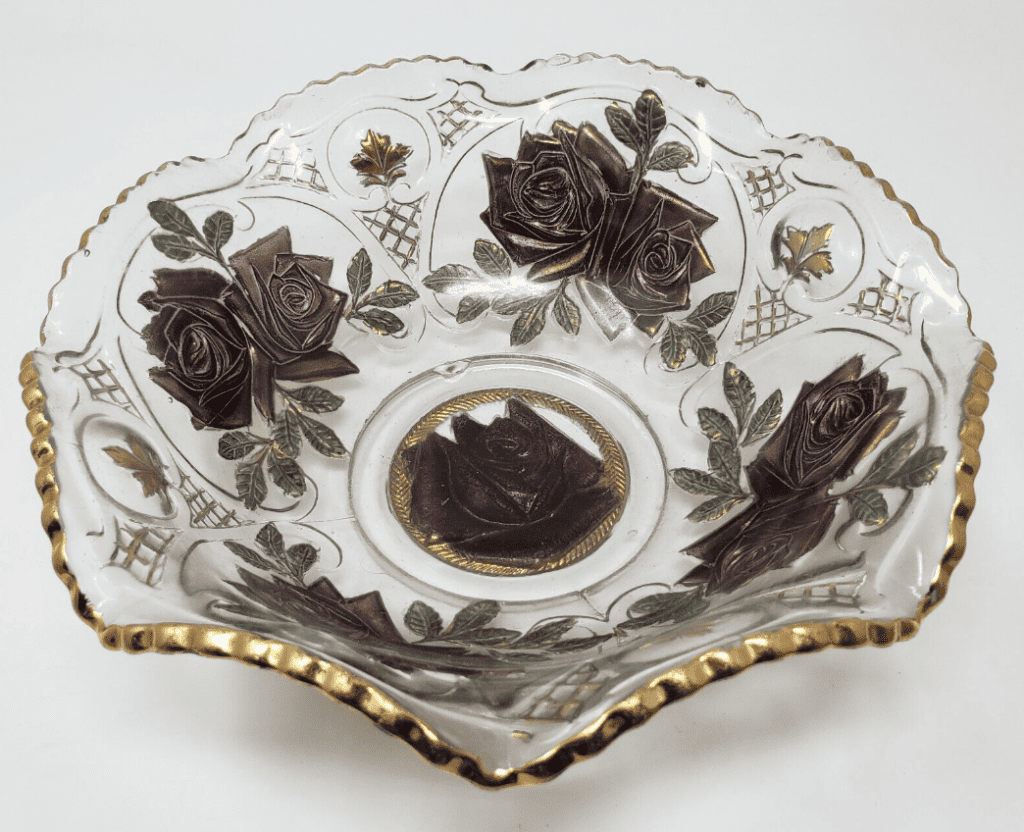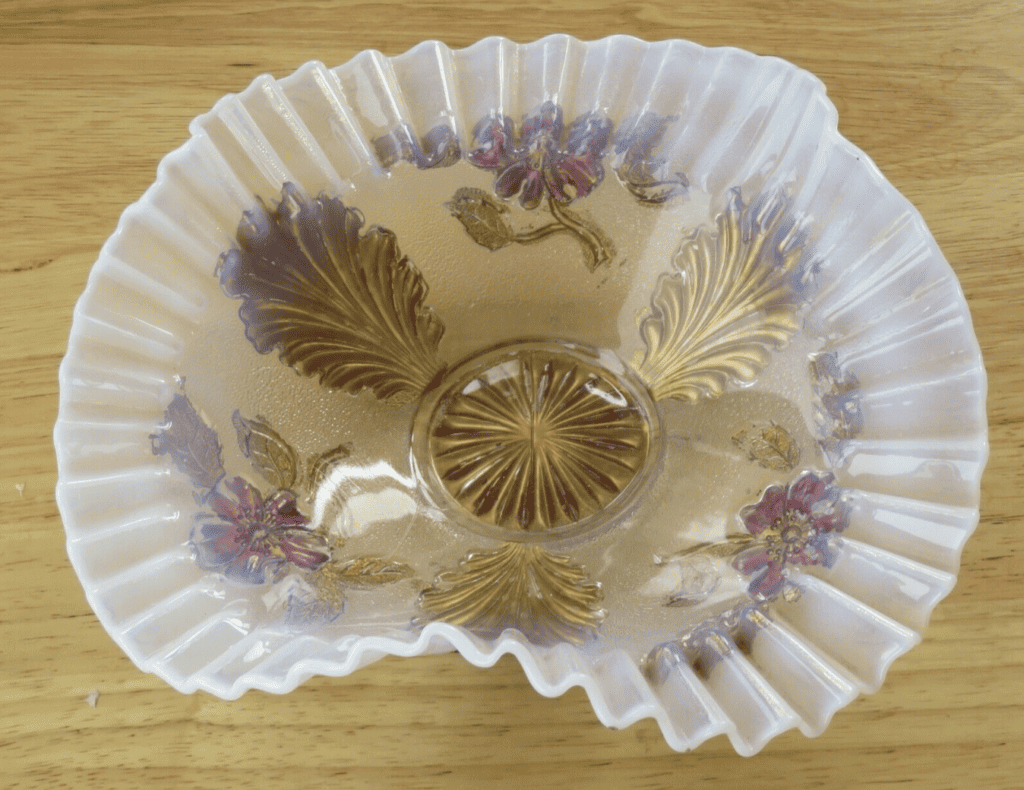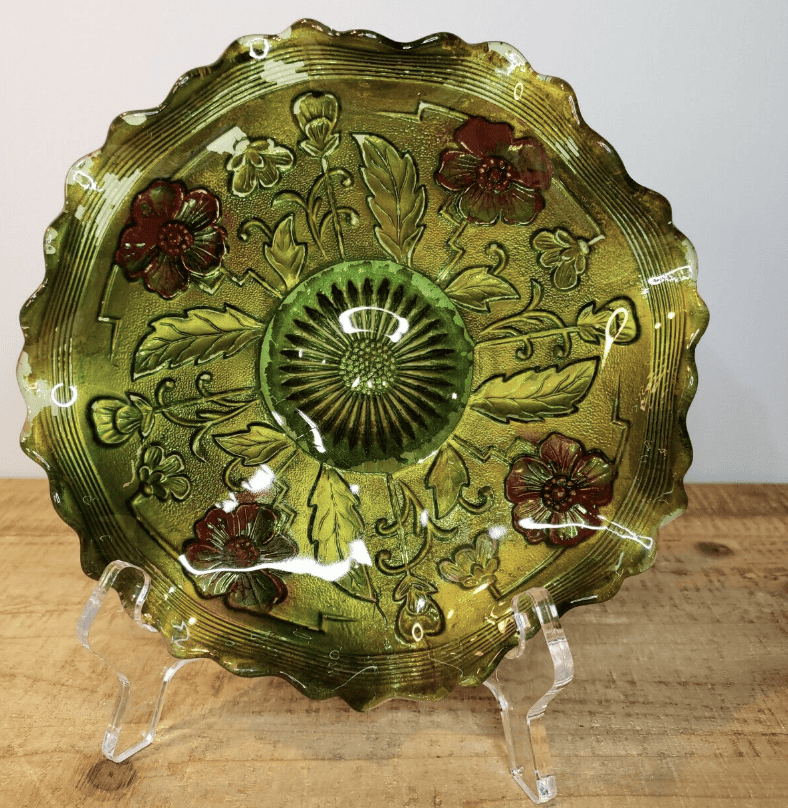No one is entirely sure how molded glass enhanced by un-fired paint came to be called Goofus glass over the years, but it certainly relates to consumer perception of the material. These low cost but visually interesting items were often handed out as prizes at fairs and carnivals. Consumers quickly caught on that the items had the look of quality and elegance, but lacked durability, and the terms they coined for the glass reflect the deception they perceived.
The term Goofus Glass emerged as an expression of the idea that only a dim-witted individual (goofus) would be fooled into thinking the items were valuable. The process used to create Goofus glass made it easy to mass produce but did not give it a high quality. The painted surface of the glass was easy to damage, and often began to peel or chip away.
The method of manufacturing was used to create a vast variety of Goofus glass items over a short period of time. The small luxuries and commemorative items celebrating holidays and events can provide insights into the common desires and priorities of the people they were made for. The name Goofus glass, emerging from public opinion, is also a tangible insight into the opinions and beliefs of the people to who it was first sold.

How did the Term Goofus Glass Originate?
At the turn of the 20th century, manufacturers began to produce glass with three-dimensional decoration and paint that was not strengthened by firing. This skipped step resulted in pretty-looking items that were much easier to damage than other types of glassware.
Glass produced using this method quickly lost value in the eyes of the consumer. There was no one term for this kind of glass. Like many mass-produced products, the proliferation of methods and products mean that it is somewhat ambiguous to define or categorize.
From the beginning, Goofus glass was marketed under a variety of elegant-sounding names. Before Goofus glass became a catch-all term, it became associated with events where it was commonly given out and would be called names such as bridal glass or carnival glass (before iridized glass took over this name).
Another early colloquial name, gypsy glass, speaks to the feeling that the glass was inherently flawed and deceptive, which were common traits of the “gypsy” stereotype of the period.

Goofus glass emerged as the main colloquial term used to refer to these items, and also serves to express the perceived value they held. While the origins of this term are uncertain, it is a testament to the poor reputation the glass had gained with the public that this became the standard name by which it is still known, almost a hundred years after it was last produced.
It is up for speculation at this point what exactly the first users of “Goofus glass” were implying with the term, and there are several equally viable interpretations. It could have been meant as an indictment of the producers, who tried to hoodwink the consumers with a product designed to appear finer that it was.
The term “goof” was commonly used as a synonym for trick at the time. Hand in hand with this concept is the insinuation that only a Goofus (idiot) would buy glass known to chip and peel. Another possibility is the suggestion that someone had made a mistake when producing it, a goof, which lead to the flaking paint. It could just as easily refer to the glass itself which is “goofy” or flawed.
How was Goofus Glass Made?
The base of Goofus glass is pressed glass. This is a method of mass production where glass is created by placing molten glass into a mold. Goofus glass is just one variety of pressed glass.
What makes something considered Goofus glass is the additional step of cold painting. Following production, colors were painted onto the surface of the glass by hand, or sometimes using an early method of industrial printing.

In some forms, the whole surface was painted, while in others, only select areas were decorated. In Goofus glass, the enamel was not fired (heated) after application. This resulted in the fragile decoration that was prone to peeling.
Today, the painted surfaces of many examples of Goofus glass show some damage or loss that they have sustained over the years. Many pieces of Goofus glass had the paint removed or washed away completely by owners over the years who wanted to use the glassware without the bother of peeling paint. As a result, undamaged pieces of Goofus are highly prized by collectors and can be sold for substantially higher prices.
When was Goofus Glass Made?
Goofus glass was produced from the very end of the nineteenth century until the mid-1920s. Variations of cold-painted glass peaked in popularity in the early 1900s, but this glassware had developed a bad reputation by the 1910s. It fell out of fashion as more durable decorative glassware entered the market.
Major producers included Dugan Diamond Company, H. Northwood Company, Indiana Glass Company, Lancaster Glass Company, and Crescent glass company. Of these, Indiana Glass Company is regarded as one of the most prolific producers.

Major producers in the glass industry created lines of cold painted glassware in the early 1900s. However, they were quick to abandon the process in favor of more durable innovations. Smaller firms continued to produce inexpensive pieces into the 1920s. Production had halted completely by the mid-1920s.
What are Common Types of Goofus Glass?
There are several major styles of Goofus glass that emerged. “Intaglio art” was a major group of early Goofus glass. “Golden Oriental” and “Egyptian Glass” are other varieties that appeared later. These names and others similar to them were crafted to lend the glass some gravitas and imply a more substantial value.
The most common examples of Goofus glass include gold paint paired with one or two additional paint colors. In most cases, the motifs and surfaces pressed into the glass lend the images dimension, while any paint applied only provides color and does so with a limited palette, predominantly red.

Common motifs include flowers, fruit, and geometric patterns common in art-nouveau and art-deco era design. Some pieces were designed to specifically commemorate an event, holiday, or individual.
Cold painting was not confined to art objects like vases and decorative plates. It was also employed in the creation of functional objects such as trinket boxes, plate and bowl sets, and drinkware. Of course, the functionality of these items was somewhat diminished by the fact that regular use would easily damage the decorative elements.
Are Goofus Glass and Carnival Glass the Same Thing?
Goofus glass is a predecessor of carnival glass. Goofus glass was used as a prize for carnivals and therefore sometimes referred to as carnival glass at the time. However, iridized glass, the material we now refer to as carnival glass was developed and superseded Goofus glass in that role. Today, Goofus glass is never referred to as carnival glass.
Source: The Glass Museum

